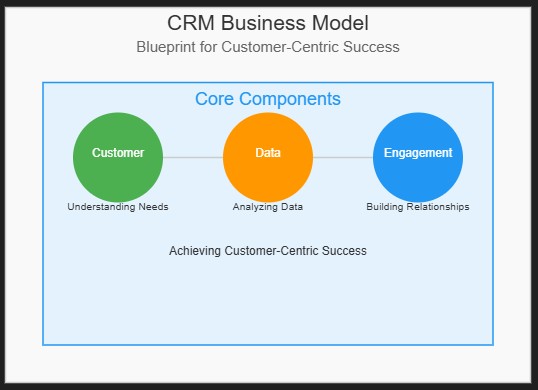In today’s hyper-competitive digital economy, where customer expectations evolve at the speed of thought, a Customer Relationship Management (CRM) business model is no longer a luxury—it’s a necessity. CRM isn’t just about software. It’s a strategic framework that empowers organizations to attract, engage, and retain customers by placing them at the center of every process.
Table of Contents
Why CRM Business Models Matter in 2025
As organizations scale, the complexity of managing customer data, touchpoints, and lifecycles multiplies. A well-defined CRM business model simplifies this chaos by aligning technology, processes, and people toward a single mission: delivering unparalleled customer experiences.
This article explores the full landscape of CRM business models—from their core components and types to real-world implementations and best practices. Whether you’re launching a startup, running an SME, or innovating inside an enterprise, understanding how CRM business models work can be a game-changer.
1. What is a CRM Business Model?
A CRM business model is a structured strategy and system for managing a company’s interactions with current and future customers. It integrates data analysis, marketing automation, sales tracking, and customer support functions under a unified platform.
Unlike traditional CRM systems that focus mainly on sales automation, modern CRM business models emphasize holistic lifecycle management, personalization, predictive analytics, and customer satisfaction.
Core Objectives:
-
Customer Acquisition: Identifying and converting leads into customers.
-
Customer Retention: Strengthening loyalty and reducing churn.
-
Customer Expansion: Upselling, cross-selling, and increasing lifetime value (CLV).
2. Core Components of a CRM Business Model
To function effectively, a CRM business model must incorporate several interlocking parts:
a. Data Management Layer
This is the backbone. It captures and stores customer data across touchpoints such as email, social media, websites, phone, and in-store.
b. Customer Segmentation
Customers are grouped based on behavior, preferences, and purchase history. This allows businesses to tailor their approach.
c. Automation Engines
From email sequences to chatbots and triggered messages, automation reduces manual effort while boosting engagement.
d. Analytics & Reporting
CRM models offer dashboards and predictive insights to monitor performance and customer satisfaction.
e. Multi-Channel Communication
Seamless integration of platforms—email, SMS, social, and calls—ensures customers get a unified brand experience.
3. Types of CRM Models
There are three primary types of CRM business models. Each serves a unique purpose depending on the company’s goals:
1. Operational CRM
Focused on automating customer-facing processes like sales, marketing, and service.
Example: Salesforce automating lead-to-deal pipelines.
2. Analytical CRM
Uses data mining, customer analytics, and behavior forecasting to drive strategic decisions.
Example: HubSpot’s reporting dashboards for campaign ROI analysis.
3. Collaborative CRM
Emphasizes inter-departmental data sharing to improve customer service and coordination.
Example: Zoho CRM integrating helpdesk, sales, and support into one flow.
4. The CRM Value Chain
Introduced by Francis Buttle, the CRM Value Chain provides a roadmap for delivering long-term value. The stages include:
-
Customer Portfolio Analysis
-
Customer Intimacy
-
Network Development
-
Value Proposition Development
-
Relationship Management
By following this framework, organizations build high-trust, high-value relationships over time.
5. Business Model Canvas for CRM
Using the Business Model Canvas as a blueprint, we can structure a CRM business model as follows:
| Component | Description |
|---|---|
| Key Partners | CRM vendors, data providers, marketing agencies |
| Key Activities | Customer tracking, personalization, segmentation |
| Value Propositions | Personalized experiences, faster service |
| Customer Relationships | Self-service portals, human touchpoints |
| Customer Segments | SMEs, enterprises, eCommerce, B2B/B2C |
| Key Resources | CRM software, data scientists, marketing tools |
| Channels | Website, mobile app, social, phone |
| Cost Structure | Subscriptions, setup, integration |
| Revenue Streams | Product sales, service contracts, affiliate offers |
6. Real-World Use Case: CRM in eCommerce
Imagine an eCommerce brand using CRM to personalize shopping experiences:
-
Step 1: Tracks customer interactions using a CRM platform (e.g., clicks, add-to-cart actions).
-
Step 2: Segments users based on browsing patterns.
-
Step 3: Sends automated product recommendations via email.
-
Step 4: Follows up post-purchase with personalized offers.
Result: Increased average order value (AOV) and higher repeat purchase rate.
7. Challenges in CRM Implementation
Implementing a CRM business model isn’t without hurdles:
-
Data Silos: Fragmented data across systems hampers performance.
-
Low User Adoption: Teams may resist change due to steep learning curves.
-
Poor Integration: If CRM doesn’t sync with existing tools, productivity drops.
-
Privacy Concerns: GDPR and other data laws require strict compliance.
Solution: Begin with a pilot program, secure stakeholder buy-in, and provide hands-on training.
8. Emerging Trends in CRM Business Models (2025 & Beyond)
a. AI-Powered CRM
From predictive lead scoring to NLP chatbots, AI enhances accuracy and engagement.
b. Hyper-Personalization
CRM systems now enable one-to-one customer journeys based on real-time data.
c. Voice & Conversational CRM
Tools like Salesforce Einstein Voice allow voice-activated data input and reporting.
d. CRM as a Platform (CaaP)
CRM is evolving into a flexible platform integrating payments, logistics, and inventory.
e. Blockchain for CRM
Used for secure, transparent customer data storage and verification.
9. CRM KPIs & Success Metrics
To measure CRM model success, track metrics such as:
-
Customer Lifetime Value (CLV)
-
Customer Acquisition Cost (CAC)
-
Retention Rate
-
Conversion Rate
-
NPS (Net Promoter Score)
10. Final Thoughts: Building a CRM-Centric Company Culture
A CRM business model is most effective when it’s part of the organizational DNA. Technology alone isn’t enough. Training, leadership, and a customer-first culture are critical.
When CRM becomes a mindset—not just a tool—organizations unlock sustainable growth, brand loyalty, and long-term profitability.
Conclusion
The CRM business model is no longer just about managing contacts or sending emails—it’s a strategic asset in the digital age. It brings structure to the chaos of customer interactions, personalizes every journey, and aligns teams with a single purpose: delivering remarkable customer value.
As businesses continue to shift from product-centric to customer-centric approaches, adopting a tailored CRM business model isn’t optional—it’s foundational to winning in the 21st-century marketplace.
💡 Ready to implement your CRM business model? Start with your customer, and the rest will follow.




